The ADATA XPG SX8200 & GAMMIX S11 NVMe SSD Review: High Performance At All Sizes
by Billy Tallis on July 25, 2018 11:00 AM ESTAnandTech Storage Bench - Heavy
Our Heavy storage benchmark is proportionally more write-heavy than The Destroyer, but much shorter overall. The total writes in the Heavy test aren't enough to fill the drive, so performance never drops down to steady state. This test is far more representative of a power user's day to day usage, and is heavily influenced by the drive's peak performance. The Heavy workload test details can be found here. This test is run twice, once on a freshly erased drive and once after filling the drive with sequential writes.
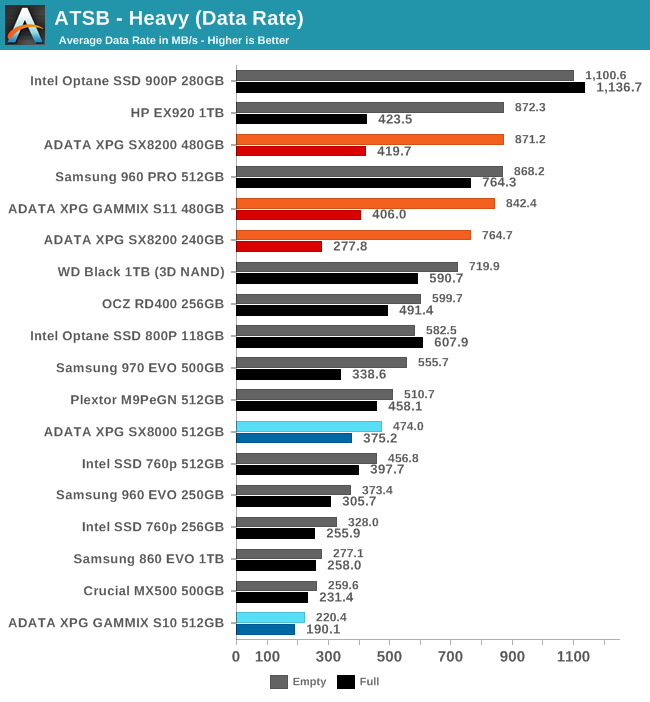
When running the Heavy test on freshly-erased drives, the average data rates from the ADATA SX8200 and GAMMIX S11 are excellent, and a huge improvement over their predecessors. Performance varies relatively little with capacity, with the 480GB drives delivering essentially the same speeds as the 1TB HP EX920, and the 240GB SX8200 is only slower by about 12%. The catch is that these drives using the SM2262 controller lose most of their performance advantage when the test is run on a full drive.

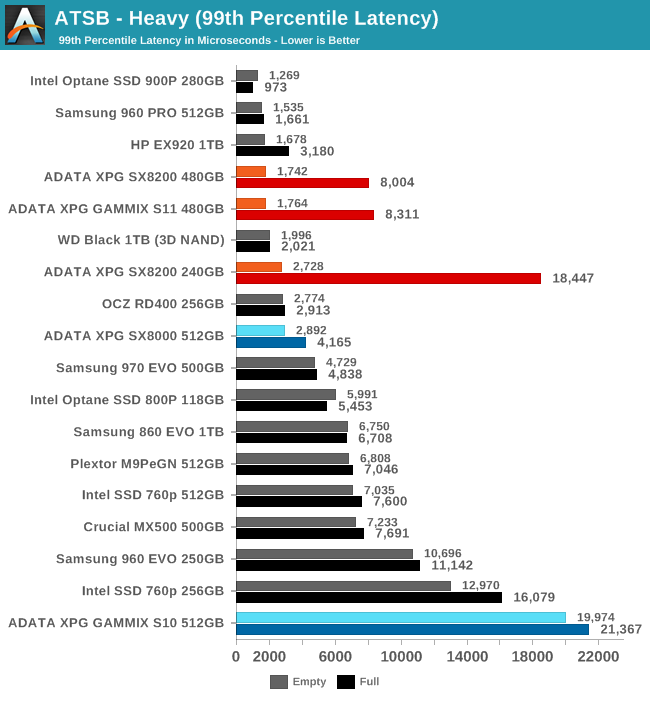
The average latencies from the latest ADATA drives are great when the test is run on an empty drive, but are on par with the competition when the drives are full. The 99th percentile latencies for the full-drive test runs are generally worse than the current-generation competition.
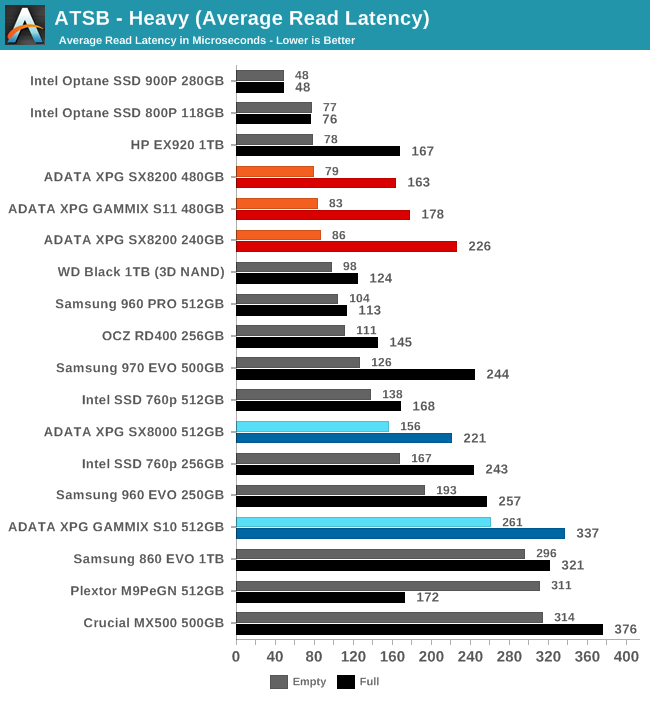
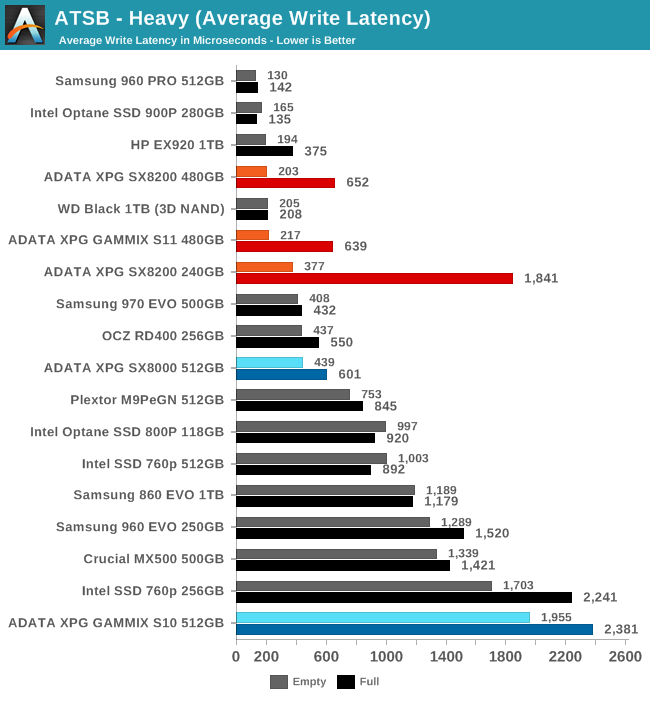
The average write latencies of the SX8200 and GAMMIX S11 highlight what seems to be the most significant weakness of this drive architecture, with full-drive performance drops that are far larger than is typical for high-end SSDs. The average read latencies also show a large performance drop, but the SX8200 and GAMMIX S11 started out with a decent lead in the empty drive test runs so this doesn't cause much trouble.
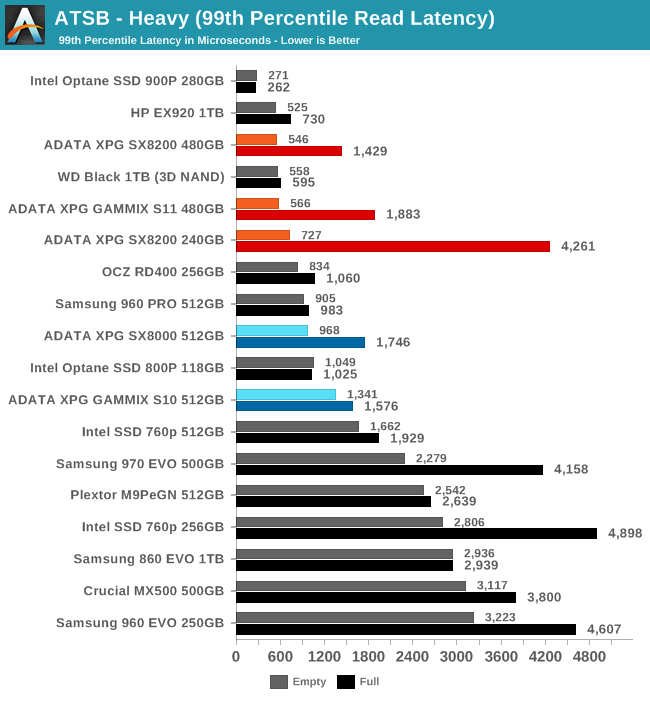
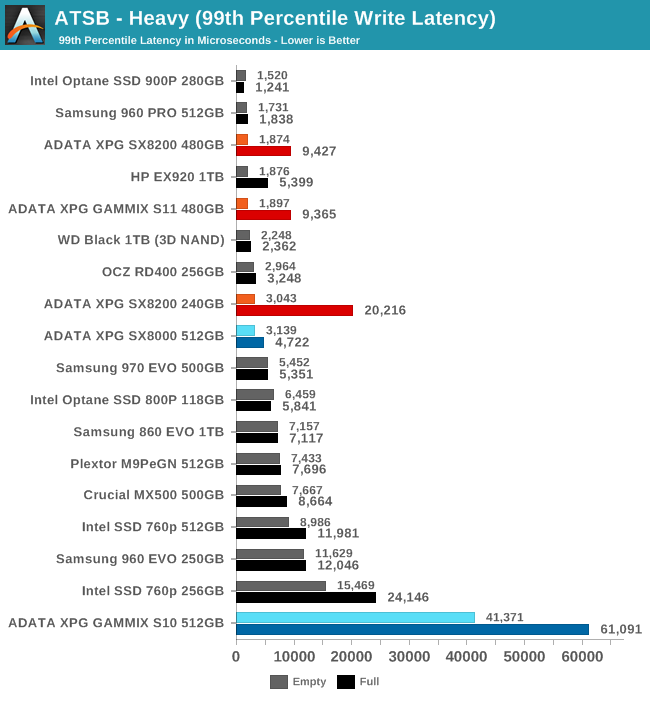
When looking at 99th percentile latency, both read and write operations suffer remarkably on the SM2262 drives when the test is run on a full drive. The 1TB HP EX920 is least affected, but the smaller ADATA drives have a real problem as their full-drive latency can be worse than mainstream SATA drives.

Only the smallest SX8200 stands out in the energy usage results. The larger models have fairly typical power efficiency for both the empty and full drive test runs, but the 240GB SX8200 loses a lot of performance when full and burns a lot more energy on background garbage collection.










19 Comments
View All Comments
stanleyipkiss - Wednesday, July 25, 2018 - link
I.... I... I want one!superunknown98 - Wednesday, July 25, 2018 - link
Yeah, what is the deal with the Intel 760p? is there a firmware that fixes it?Billy Tallis - Wednesday, July 25, 2018 - link
There hasn't been a firmware update for the 760p yet: https://www.intel.com/content/www/us/en/support/ar...Rick F - Wednesday, July 25, 2018 - link
Thank you. This helped me avoid two different mistakes buying an M.2 for an Asrock x370 Taichi, All of the nonworking Adata's are on the QVL, along with the 8200 that works.The 8200 read speed is comparable to Samsung, but the write speed is about half as fast as Samsung. For the cost the 8200 is much more affordable for PCIe 3.0 nvme 1.3.
So now what to do...a few years ago, B+M M.2 Sata was pretty standard. PCIe was Samsung only and cost too much. Now M.2 is in transition and not so easy.
Think I'll sleep on it, and choose a lot of Sata space, or M.2 with a controller that hasn't gone through the wear leveling of an ssd yet...Again thanks for the heads up.
CheapSushi - Wednesday, July 25, 2018 - link
This just makes me want the Intel 900P even more. I'm hoping to have Optane drives for performance, cache and main programs & OS and just use QLC NAND drives for storage.Amandtec - Thursday, July 26, 2018 - link
How about run Fuzedrive with 2GB ramdrive, 32GB Optane, 256QLC and 4+TB HDD. Everything should kind of work out quite nicely (unless you mostly access very large files only once).deil - Thursday, July 26, 2018 - link
that's my plan, I just want to use 58 GB optane drive, and maybe 512GB mv500 SSD.Death666Angel - Thursday, July 26, 2018 - link
I guess some people, including me, want to KISS regarding their PC storage tiers. How are the failure states when it comes to the Fuzedrive implementation? Is it all just cached on the faster stuff and backed up on the normal HDD, so a drive failure "in front" isn't catastrophic? I'm personally super fine with my M.2 NVME SSD (960 Evo on sale) as an OS drive and a spinning platter for other stuff on my main PC (soon to be replaced with a M.2 SATA / NVME SSD depending on motherboard upgrades) and a whole bunch of HDDs in my file server. I don't see a scenario where I need optane like performance just yet. And for the Fuzedrive thing, see above, plus I don't need simple documents or pictures loading faster, they load just fine for my taste. :) Avoids all the potential headaches of another layer of software between me an my data.DigitalFreak - Thursday, July 26, 2018 - link
With FuzeDrive, if either drive fails, you lose all data. Similar to RAID 0.Samus - Friday, July 27, 2018 - link
Backblaze is $50 a year.